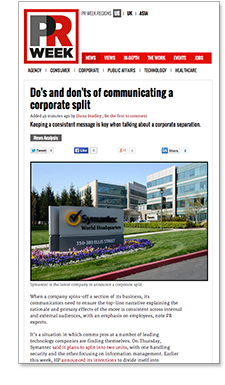PRWeek
by Diana Bradley
Keeping a consistent message is key when talking about a corporate separation.
When a company spins-off a section of its business, its communicators need to ensure the top-line narrative explaining the rationale and primary effects of the move is consistent across internal and external audiences, with an emphasis on employees, note PR experts.
It’s a situation in which comms pros at a number of leading technology companies are finding themselves. On Thursday, Symantec said it plans to split into two units, with one handling security and the other focusing on information management. Earlier this week, HP announced its intentions to divide itself into companies working on business technology and developing PCs and printers. EBay CEO John Donahoe has also moved to spin off the company’s PayPal unit.
Matthew Hutchison, corporate communications SVP at Tribune Publishing, which completed its spinoff from parent Tribune Media in August, notes that whatever message is shared internally should be written in a way that resonates with external audiences. That is in case an employee shares it with a reporter, financial analyst, or blogger.
Dan Shaw, EVP of Edelman’s Los Angeles office, notes that "tailored messaging must be developed to help employees understand why the change is happening, how it will impact their work, and what is expected of them."
"On a parallel track, communicators must also assess how visible the change will be to external audiences and what the potential impact will be, and [develop] messages that create positive understanding and mitigate any potential reputational risks," he adds.
Hutchison agrees on the importance of extending the message to employees.
"Employees need to feel that there is a vision or roadmap the company has set out, and that they have an important role to play in the specific transition or carrying on the day-to-day facets of the business and serving customers and partners as they normally would," he adds. "It is important to keep everyone motivated and aligned when communicating about a spinoff."
In terms of mediums, Hutchison acknowledges email may be seen as an "old school" approach, but says it is the most effective way for quickly, effectively, and efficiently disseminating information to staffers when announcing a split.
Frequent staff and leadership team meetings, along with the use of intranet platforms such as Chatter, should also be employed to communicate with staffers, he adds.
After the announcement of a spinoff, a company needs to stay on top of employee concerns as they arise, consistently making themselves available to engage in a dialogue so staffers understand all facets of a transition. As part of the process, leaders should follow through on regularly providing employees with timely and open communications with real information that doesn’t come across as corporate sound bites, says Shaw.
"There should be ongoing opportunities for employees to ask questions, share ideas, and express concerns so they feel invested in the process," he says. "Leaders should also share stories, both personal and professional, that reinforce the rationale or benefits of the change they are driving."
By keeping employees in the loop, there’s a better chance staffers will serve as brand ambassadors to external stakeholders. If customers, for instance, have a question about a company’s new structure and what it means for them, they are going to call who they know: employees, according to Prosek Partners MD Josh Passman.
What to avoid in spinoff comms
Activist investors are increasingly driving companies to initiative spin-offs, notes Passman. In situations like this, corporations need to avoid making a split look like a knee-jerk reaction to investors’ demands.
For instance, after opposing the idea for months, eBay said last week that it plans to spin off PayPal into a separate publicly traded business. Activist shareholder Carl Icahn had encouraged the companies’ separation since a January conference call.
But eBay president and CEO John Donahoe explained in a press release that a recent strategic review found keeping eBay and PayPal together was becoming "less advantageous."
"A company should position itself as being open to hearing other perspectives, because no one wants to be seen as close-minded or not open to other ideas, especially the ideas of their investors," explains Passman. "But companies also need to be cautious about providing activist investors with too much support or recognition; it shouldn’t look like an activist investor’s opinion is driving business decisions."
To avoid this, a company should focus its message on how the split is part of its long-term business strategy. For example, it bodes well if a brand – within a spinoff announcement – can point to earlier reports that say it is evaluating new ways to create shareholder value or increase opportunities to expand into other markets, Passman says.
In most spinoffs, one company will have high-growth potential, and the other will be the more stable cash cow. Yet companies need to be careful in their communications to not disparage either brand, he adds.
"A company shouldn’t highlight how one set of employees, investors, customers, and stakeholder groups will benefit relative to the other group," Passman explains. "It is best to position [the split] as having equal benefit to both parties; you never want to say anything negative about either of the entities."
In relation to eBay’s spinoff of PayPal, both companies were positioned as being able to capitalize on respective growth opportunities in the "rapidly changing global commerce and payments landscape, and [it] is the best path for creating sustainable shareholder value."
"You have two entities that coexisted, and now they are going in their own separate ways, so the real challenge is striking that balance of promoting and positioning this as a win-win across the board," Passman adds.

